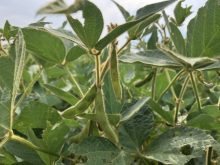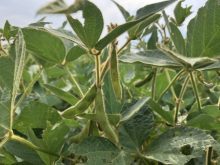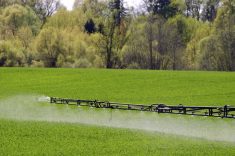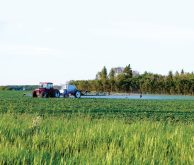Chicago | Reuters — With Monsanto’s latest flagship weed killer, dicamba, banned in Arkansas and under review by U.S. regulators over concerns it can drift in the wind, farmers and weed scientists are also complaining that confusing directions on the label make the product hard to use safely.
Dicamba, sold under different brand names by BASF and DuPont, can vaporize under certain conditions and the wind can blow it into nearby crops and other plants. The herbicide can damage or even kill crops that have not been genetically engineered to resist it.
Read Also

Sigurdson applauds Alberta farmers
With Alberta’s harvest virtually wrapped up for 2025, provincial Agriculture Minister RJ Sigurdson offered the government’s congratulations to the province’s farmers.
To prevent that from happening, Monsanto created a 4,550-word label with detailed instructions. Its complexity is now being cited by farmers and critics of the product. It was even singled out in a lawsuit as evidence that Monsanto’s product may be virtually impossible to use properly.
At stake for Monsanto is the fate of Xtend soybeans, its largest ever biotech seed launch.
Monsanto’s label, which the U.S. Environmental Protection Agency (EPA) reviewed and approved, instructs farmers to apply the company’s XtendiMax with VaporGrip on its latest genetically engineered soybeans only when winds are blowing at least three miles per hour, but not more than 15 mph.
(The product’s Canadian label puts the acceptable wind speed range between three and 15 km/h, or about 1.9 to 9.3 mph.)
Growers must also spray it from no higher than 24 inches above the crops. They must adjust spraying equipment to produce larger droplets of the herbicide when temperatures creep above 91 F, or 32.8 C.
(On the Canadian label, farmers are instructed to not spray when the temperature is expected to exceed 30 C. It also calls for farmers to “use coarse sprays since they are less likely to drift than fine sprays” and to avoid spraying in high humidity or fog.)
Also, after using the product, farmers must triple-rinse spray tanks and equipment.
“The restriction on these labels is unlike anything that’s ever been seen before,” said Bob Hartzler, an agronomy professor and weed specialist at Iowa State University.
The label instructions are also of interest to lawyers for farmers suing Monsanto, BASF and DuPont over damage they attribute to the potent weed killer moving off-target to nearby plants.
A civil lawsuit filed against the companies in federal court in St. Louis last month alleged it might be impossible to properly follow the label. Restrictions on wind speed, for example, do not allow for timely sprayings over the top of growing soybeans, according to the complaint.
The companies failed “to inform the EPA that their label instructions were unrealistic,” the lawsuit said.
Monsanto said that while its label is detailed, it is not difficult to follow.
“It uses very simple words and terms,” Scott Partridge, Monsanto’s vice-president of strategy, told Reuters. “They are not complex in a fashion that inhibits the ability of making a correct application.”
BASF and DuPont could not immediately be reached for comment on the lawsuit on Friday.
Monsanto and BASF have said they trained thousands of farmers to properly use dicamba. Monsanto also said the crop damage seen this summer likely stemmed largely from farmers who did not follow label instructions.
Those detailed instructions led some growers and professional spraying companies to avoid the herbicide altogether.
Richard Wilkins, a Delaware farmer, abandoned plans to plant Monsanto’s dicamba-resistant soybeans, called Xtend, this year because a local company would not spray the herbicide.
“The clean-out procedure that you have to go through to ensure that you don’t have any residue remaining in the applicator equipment is quite onerous,” he said.
In Missouri, farm co-operative MFA Inc. said it stopped spraying dicamba for customers last month partly because high temperatures made it too difficult to follow the label.
Studying wind, temperatures
The EPA is reviewing label instructions following the reports of crop damage.
Monsanto has a lot riding on the EPA review. The company’s net sales increased one per cent to US$4.2 billion in the quarter ended on May 31 from a year ago, partly due to higher U.S. sales of Xtend soybeans. Since January, the company has increased its estimate for 2017 U.S. plantings to 20 million acres from 15 million.
One confusing requirement on its dicamba label, farmers said, prohibits spraying during a “temperature inversion,” a time when a stable atmosphere can increase the potential for the chemical to move to fields that are vulnerable.
To follow the rule, some growers used their smart phones to check weather websites for wind speeds and information on inversions.
“You have to be a meteorologist to get it exactly right,” said Hunter Raffety, a Missouri farmer who believes dicamba damaged soybeans on his farm that could not resist the chemical.
— Reporting for Reuters by Tom Polansek and Karl Plume in Chicago. Includes files from AGCanada.com Network staff.
















